Refracting telescope
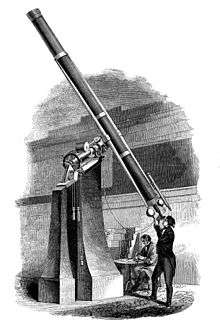
A refracting telescope (also called a refractor) is a type of optical telescope that uses a lens as its objective to form an image (also referred to a dioptric telescope). The refracting telescope design was originally used in spy glasses and astronomical telescopes but is also used for long focus camera lenses. Although large refracting telescopes were very popular in the second half of the 19th century, for most research purposes the refracting telescope has been superseded by the reflecting telescope which allows larger apertures. A refractor's magnification is calculated by dividing the focal length of the objective lens by that of the eyepiece.[1]
Invention
Refractors were the earliest type of optical telescope. The first practical refracting telescopes appeared in the Netherlands about 1608, and were credited to three individuals, Hans Lippershey and Zacharias Janssen, spectacle-makers in Middelburg, and Jacob Metius of Alkmaar. Galileo Galilei, happening to be in Venice in about the month of May 1609, heard of the invention and constructed a version of his own. Galileo then communicated the details of his invention to the public, and presented the instrument itself to the Doge Leonardo Donato, sitting in full council.[2][3]
Refracting telescope designs
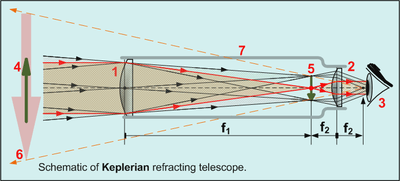
All refracting telescopes use the same principles. The combination of an objective lens 1 and some type of eyepiece 2 is used to gather more light than the human eye is able to collect on its own, focus it 5, and present the viewer with a brighter, clearer, and magnified virtual image 6.
The objective in a refracting telescope refracts or bends light. This refraction causes parallel light rays to converge at a focal point; while those not parallel converge upon a focal plane. The telescope converts a bundle of parallel rays to make an angle α, with the optical axis to a second parallel bundle with angle β. The ratio β/α is called the angular magnification. It equals the ratio between the retinal image sizes obtained with and without the telescope.[4]
Refracting telescopes can come in many different configurations to correct for image orientation and types of aberration. Because the image was formed by the bending of light, or refraction, these telescopes are called refracting telescopes or refractors.
Galileo's telescope
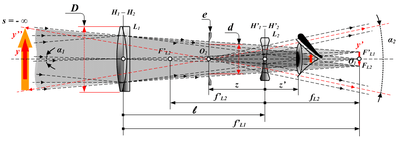
The design Galileo Galilei used in 1609 is commonly called a Galilean telescope. It used a convergent (plano-convex) objective lens and a divergent (plano-concave) eyepiece lens (Galileo, 1610).[6] A Galilean telescope, because the design has no intermediary focus, results in a non-inverted and upright image.
Galileo’s best telescope magnified objects about 30 times. Because of flaws in its design, such as the shape of the lens and the narrow field of view, the images were blurry and distorted. Despite these flaws, the telescope was still good enough for Galileo to explore the sky. The Galilean telescope could view the phases of Venus, and was able to see craters on the Moon and four moons orbiting Jupiter.
Parallel rays of light from a distant object (y) would be brought to a focus in the focal plane of the objective lens (F′ L1 / y′). The (diverging) eyepiece (L2) lens intercepts these rays and renders them parallel once more. Non-parallel rays of light from the object traveling at an angle α1 to the optical axis travel at a larger angle (α2 > α1) after they passed through the eyepiece. This leads to an increase in the apparent angular size and is responsible for the perceived magnification.
The final image (y″) is a virtual image, located at infinity and is the same way up as the object.
Keplerian telescope
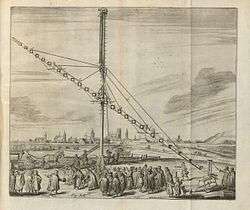
The Keplerian telescope, invented by Johannes Kepler in 1611, is an improvement on Galileo's design.[8] It uses a convex lens as the eyepiece instead of Galileo's concave one. The advantage of this arrangement is that the rays of light emerging from the eyepiece are converging. This allows for a much wider field of view and greater eye relief, but the image for the viewer is inverted. Considerably higher magnifications can be reached with this design, but to overcome aberrations the simple objective lens needs to have a very high f-ratio (Johannes Hevelius built one with a 46-metre (150 ft) focal length, and even longer tubeless "aerial telescopes" were constructed). The design also allows for use of a micrometer at the focal plane (used to determine the angular size and/or distance between objects observed).
Achromatic refractors
The achromatic refracting lens was invented in 1733 by an English barrister named Chester Moore Hall, although it was independently invented and patented by John Dollond around 1758. The design overcame the need for very long focal lengths in refracting telescopes by using an objective made of two pieces of glass with different dispersion, 'crown' and 'flint glass', to limit the effects of chromatic and spherical aberration. Each side of each piece is ground and polished, and then the two pieces are assembled together. Achromatic lenses are corrected to bring two wavelengths (typically red and blue) into focus in the same plane. The era of the 'great refractors' in the 19th century saw large achromatic lenses culminating with the largest achromatic refractor ever built, the Great Paris Exhibition Telescope of 1900.
Apochromatic refractors
Apochromatic refractors have objectives built with special, extra-low dispersion materials. They are designed to bring three wavelengths (typically red, green, and blue) into focus in the same plane. The residual color error (tertiary spectrum) can be up to an order of magnitude less than that of an achromatic lens. Such telescopes contain elements of fluorite or special, extra-low dispersion (ED) glass in the objective and produce a very crisp image that is virtually free of chromatic aberration.[9] Due to the special materials needed in the fabrication, apochromatic refractors are usually more expensive than telescopes of other types with a comparable aperture.
Technical considerations

Refractors suffer from residual chromatic and spherical aberration. This affects shorter focal ratios more than longer ones. A 100 mm (4 in) f/6 achromatic refractor is likely to show considerable color fringing (generally a purple halo around bright objects). A 100 mm (4 in) f/16 has little color fringing.
In very large apertures, there is also a problem of lens sagging, a result of gravity deforming glass. Since a lens can only be held in place by its edge, the center of a large lens sags due to gravity, distorting the images it produces. The largest practical lens size in a refracting telescope is around 1 meter (39 in).[10]
There is a further problem of glass defects, striae or small air bubbles trapped within the glass. In addition, glass is opaque to certain wavelengths, and even visible light is dimmed by reflection and absorption when it crosses the air-glass interfaces and passes through the glass itself. Most of these problems are avoided or diminished in reflecting telescopes, which can be made in far larger apertures and which have all but replaced refractors for astronomical research.
List of the largest refracting telescopes
A list of the largest refracting telescopes over 60 cm (24 in) diameter.
- Great Paris Exhibition Telescope of 1900 (1.25 m or 49 in) – dismantled after exhibition
- Yerkes Observatory (100 cm or 40 in)
- Swedish 1-m Solar Telescope (98 cm or 39 in)
- Lick Observatory (91 cm or 36 in)
- Paris Observatory (83 cm or 33 in, + 62 cm or 24 in)
- John Wall Telescope a 30" f12 refractor, the largest ever built by an individual maker (John Wall, inventor of the Crayford focuser). It is the equal fifth largest in the world with that at the Paris Observatory. It is now operated by the Hanwell Astronomical Society.[11]
- Nice Observatory (77 cm or 30 in)
- Archenhold Observatory – the longest refracting telescope ever built (68 cm or 27 in × 21 m or 69 ft focal length)
- Lowell Observatory (61 cm or 24 in)
 The Great Refractor at the Astrophysical Institute Potsdam, Germany
The Great Refractor at the Astrophysical Institute Potsdam, Germany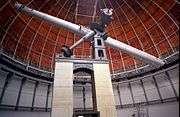
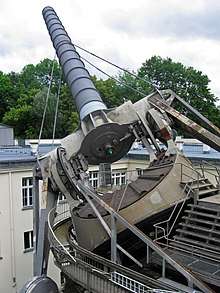 The Great Refractor at the Archenhold Observatory in Berlin
The Great Refractor at the Archenhold Observatory in Berlin
- 51-centimeter (20 in) refractor at the Observatories at Chabot Space & Science Center in Oakland, California
- 20-centimeter (8 in) refractor at the Observatories at Chabot Space & Science Center in Oakland, California
- Refractor at the Observatory in Aachen, Germany
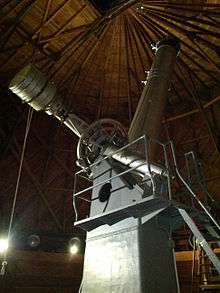
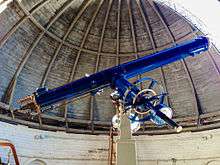
 Diagram of a commercial refractor
Diagram of a commercial refractor Apochromatic refractor
Apochromatic refractor Coin-operated telescope in Germany
Coin-operated telescope in Germany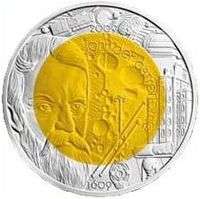 International Year of Astronomy commemorative Austrian coin featuring a refracting telescope
International Year of Astronomy commemorative Austrian coin featuring a refracting telescope
See also
References
- ↑ "Telescope Calculations". Northern Stars. Retrieved 2013-12-20.
- ↑ "The First Telescopes". American Institute of Physics. Retrieved 15 July 2015.
- ↑ "Physics for Scientists and Engineers, Refractors were the earliest type of optical telescope". Raymond A. Serway. Retrieved 15 July 2015.
- ↑ Stephen G. Lipson, Ariel Lipson, Henry Lipson, Optical Physics 4th Edition, Cambridge University Press, ISBN 978-0-521-49345-1
- ↑ http://upload.wikimedia.org/wikipedia/commons/1/17/Galileantelescope_2.png
- ↑ Sidereus Nuncius or The Sidereal Messenger, 1610, Galileo Galilei et al., 1989, pg. 37, The University of Chicago Press, Albert van Helden tr., (History Dept. Rice University, Houston, TX), ISBN 0-226-27903-0.
- ↑ Hevelius, Johannes (1673). Machina Coelestis. First Part. Auctor.
- ↑ Tunnacliffe, AH; Hirst JG (1996). Optics. Kent, England. pp. 233–7. ISBN 0-900099-15-1.
- ↑ "Starizona's Guide to CCD Imaging". Starizona.com. Retrieved 17 October 2013.
- ↑ "Physics Demystified" By Stan Gibilisco, ISBN 0-07-138201-1, page 515
- ↑ "John Wall refractor - Hanwell Community Observatory". www.hanwellobservatory.org.uk.
External links
| Wikimedia Commons has media related to Refracting telescopes. |
- nasa.gov – Build a Telescope
- Making a Galilean Telescope
- BUILDING A GALILEAN TELESCOPE
- OPTICS OF THE SINGLET REFRACTOR: GALILEO vs. KEPLER
- Angular and Linear Fields of View of Galilean Telescopes and Telemicroscopes
- Refracting telescopes
- Introduction to Galileo's Telescope